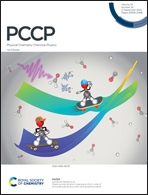Silica dimerization in the presence of divalent cations†
Abstract
The presence of monovalent cations and organic tetraalkylammonium ions is known to affect the reaction pathway and chemical kinetics of the silica oligomerization reaction which is important for sol–gel chemistry studies. A detailed theoretical study focusing on the chemical reaction pathway for the dimerisation process in the presence of a divalent cation is presented in this study. Different condensation pathways such as neutral, anionic-I and anionic-II along with their relative possibilities in dimerization have been explored. It has been demonstrated that with an increase in the pH of solution, manifested through the presence of deprotonated ions (as in the anionic cases with or without the presence of divalent cations), the activation activation barrier of the dimerization reaction is lowered. It has also been demonstrated that the addition of divalent cations raises the activation barriers for the reaction and delays the overall dimerisation reaction. The stability and bond characteristics of the bridging Si–OH bond of the resulting dimer products have also been determined. Activation energy barriers for the anionic case have also been observed to vary based upon the dihedral arrangement of the hydroxyl group bonded with the silicon and the orientation of the nucleophilic attack.


 Please wait while we load your content...
Please wait while we load your content...